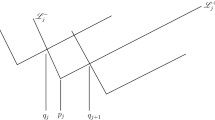Abstract
A famous conjecture of Littlewood (c. 1930) concerns approximating two real numbers by rationals of the same denominator, multiplying the errors. In a lesser-known paper, Wang and Yu (Chin Ann Math 2:1–12, 1981) established an asymptotic formula for the number of such approximations, valid almost always. Using the quantitative Koukoulopoulos–Maynard theorem of Aistleitner–Borda–Hauke, together with bounds arising from the theory of Bohr sets, we deduce lower bounds of the expected order of magnitude for inhomogeneous and fibre refinements of the problem.
Similar content being viewed by others
Data availability
Data sharing is not applicable to this article as no datasets were generated or analysed during the current study.
References
Aistleitner, C., Borda, B., Hauke, M.: On the metric theory of approximations by reduced fractions: a quantitative Koukoulopoulos–Maynard theorem. arXiv:2202.00936
Beresnevich, V., Haynes, A., Velani, S.: Sums of Reciprocals of Fractional Parts and Multiplicative Diophantine Approximation, vol. 263. Mem. Amer. Math. Soc. (2020)
Chow, S.: Bohr sets and multiplicative diophantine approximation. Duke Math. J. 167, 1623–1642 (2018)
Chow, S., Technau, N.: Higher-rank Bohr sets and multiplicative diophantine approximation. Compos. Math. 155, 2214–2233 (2019)
Chow, S., Technau, N.: Littlewood and Duffin–Schaeffer-type problems in diophantine approximation. Mem. Am. Math. Soc. (to appear)
Duffin, R.J., Schaeffer, A.C.: Khintchine’s problem in metric Diophantine approximation. Duke Math. J. 8, 243–255 (1941)
Fregoli, R.: On a counting theorem for weakly admissible lattices. Int. Math. Res. Not. 2021, 7850–7884 (2021)
Gallagher, P.X.: Metric simultaneous diophantine approximation. J. Lond. Math. Soc. 37, 387–390 (1962)
Harman, G.: Metric Number Theory, London Math. Soc. Lecture Note Ser. (N.S.), vol. 18. Clarendon Press, Oxford (1998)
Khintchine, A.I.: Einige Sätze über Kettenbrüche, mit Anwendungen auf die Theorie der Diophantischen Approximationen. Math. Ann. 92, 115–125 (1924)
Koukoulopoulos, D., Maynard, J.: On the Duffin-Schaeffer conjecture. Ann. Math. 2(192), 251–307 (2020)
Schmidt, W.M.: A metrical theorem in diophantine approximation. Can. J. Math. 12, 619–631 (1960)
Wang, Y., Yu, K.R.: A note on some metrical theorems in Diophantine approximation. Chin. Ann. Math. 2, 1–12 (1981)
Widmer, M.: Asymptotic diophantine approximation: the multiplicative case. Ramanujan J. 43, 83–93 (2017)
Acknowledgements
We thank Jakub Konieczny for raising the question, as well as for feedback on an earlier version of this manuscript, and we thank Christoph Aistleitner for a helpful conversation
Author information
Authors and Affiliations
Corresponding author
Additional information
Publisher's Note
Springer Nature remains neutral with regard to jurisdictional claims in published maps and institutional affiliations.
NT was supported by a Schrödinger Fellowship of the Austrian Science Fund (FWF): Project J 4464-N.
Appendix A: Computing a volume
Appendix A: Computing a volume
Here, we deduce Theorem 1.6 from [9, Theorem 4.6] and the argument of Wang and Yu [13, Section 1]. For \({\lambda }> 0\), define
and
By symmetry and [9, Theorem 4.6], for almost all \({\varvec{{\alpha }}}\in \mathbb R^k\), we have
where
Thus, it remains to show that
Lemma A.1
For \(k \in \mathbb N\) and \({\lambda }> 0\), we have
Proof
We induct on k. The base case is clear: \(\mu _1(\mathcal B_1({\lambda })) = \min \{ {\lambda }, 1\}\). Now let \(k \ge 2\), and suppose the conclusion holds with \(k-1\) in place of k. We may suppose that \(0< {\lambda }< 1\). We compute that
\(\square \)
In view of Schmidt’s Theorem 1.4, we may assume that \(k \ge 2\). Now, as
and as \(\psi (n) < 2^{-k}\) for large n, we have
Since \(\psi (n) \rightarrow 0\) as \(n \rightarrow \infty \), we have \(\Psi _{k-1}^\times (N) + 1 = o(\Psi _k^\times (N))\), and hence, (A.1), completing the proof of Theorem 1.6.
Rights and permissions
About this article
Cite this article
Chow, S., Technau, N. Counting multiplicative approximations. Ramanujan J 62, 241–250 (2023). https://doi.org/10.1007/s11139-022-00610-3
Received:
Accepted:
Published:
Issue Date:
DOI: https://doi.org/10.1007/s11139-022-00610-3



